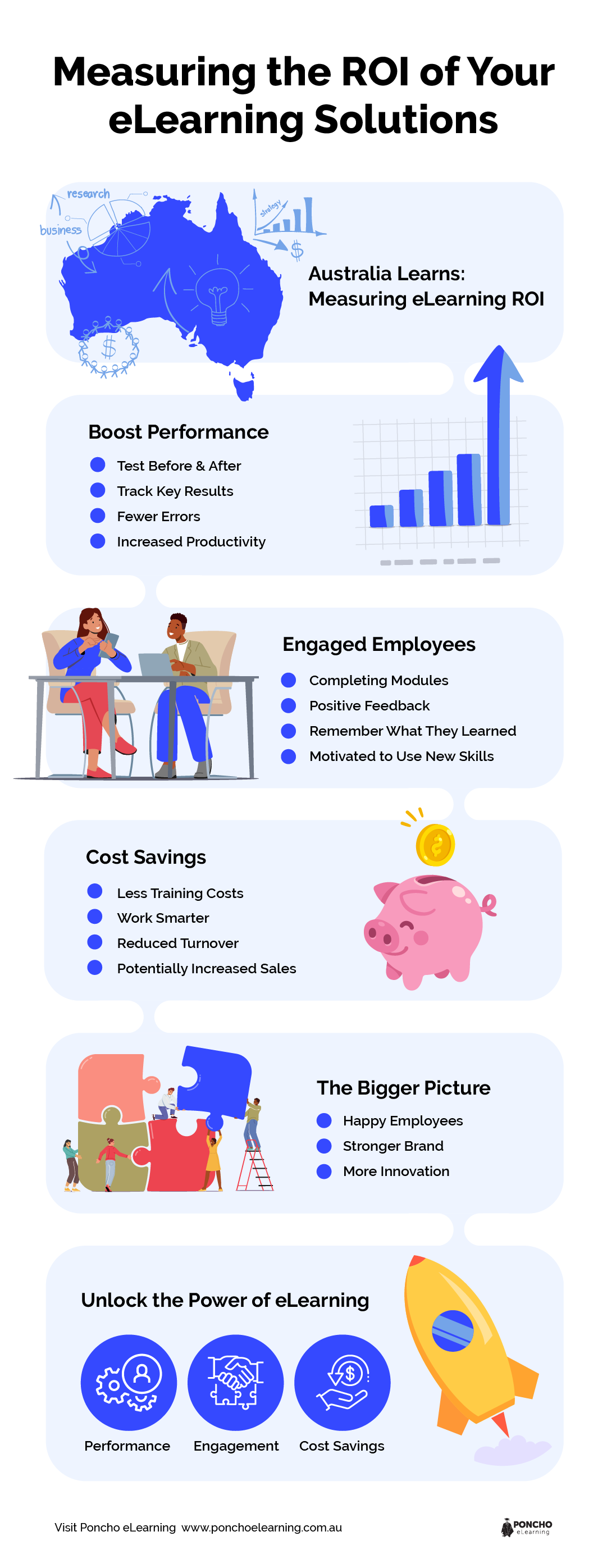In today’s competitive Australian business landscape, investing in employee training is no longer a luxury; it’s a strategic necessity. But with tight budgets and a need for demonstrable results, many companies are asking the crucial question: how do I measure the return on investment (ROI) of my eLearning solutions?
Fear not, fellow Aussies! While measuring the ROI of eLearning can seem daunting, wthere are several effective methods that go beyond simply tracking login numbers. Here, we’ll explore 4 key ways to assess the impact of your eLearning solutions and demonstrate the real value they bring to your business.

1. Track Performance Improvements of eLearning Solutions
The ultimate goal of any training program is to equip your employees with the skills and knowledge they need to perform their jobs more effectively. Here’s how to gauge whether your eLearning solutions are delivering:
- Pre and Post-Training Assessments: Develop simple tests or quizzes to assess learners’ knowledge before and after completing the eLearning program. This helps quantify the increase in knowledge gained.
- Track On-the-Job Performance: Monitor key performance indicators (KPIs) relevant to the training objectives. For example, if the eLearning focused on customer service skills, you might track customer satisfaction ratings or sales conversion rates.
- Reduced Error Rates: Look for a decrease in errors or rework associated with the skills addressed in the eLearning. This results in reduced expenses and increased effectiveness.
- Increased Productivity: Evaluate whether employees are completing tasks faster or achieving higher output after undergoing the eLearning program.
2. Measure Employee Engagement
Employee satisfaction, productivity, and attrition are all higher among engaged workers. Measuring employee engagement in relation to your eLearning solutions helps assess their overall effectiveness:
- Completion Rates: Monitor what percentage of employees actually complete the eLearning modules assigned to them.
- Learner Feedback: Conduct surveys or focus groups to gather feedback on the eLearning experience. Ask about the content, format, difficulty level, and overall effectiveness of improving their skills.
- Knowledge Retention Rates: Test learners at regular intervals after completing the eLearning to see how well they retain the information over time.
- Increased Motivation: Observe whether employees are more enthusiastic and proactive in applying their newly acquired skills after undergoing the eLearning program.
3. Calculate Cost Savings
While the initial investment in eLearning development might seem like a cost, the long-term benefits can translate into significant savings for your business. Here are some other things to think about:
- Reduced Training Costs: eLearning eliminates the need for in-person training sessions, saving on trainer fees, travel expenses, and venue costs.
- Improved Efficiency: By equipping employees with the skills they need to complete tasks efficiently, you can reduce rework, errors, and wasted time.
- Lower Employee Turnover: Engaged and skilled employees are more likely to stay with the company, reducing the cost associated with recruitment and onboarding new staff.
- Increased Sales: Enhanced customer service skills and product knowledge can lead to increased sales and customer satisfaction.
To accurately assess cost savings, be sure to factor in the following:
- Development costs of the eLearning program
- Delivery costs (hardware, software)
- Employee time spent on the eLearning modules
By comparing these costs to the savings identified in the areas mentioned above, you can paint a clear picture of the overall cost-effectiveness of your eLearning solutions.
4. Consider the Broader Impact of eLearning Solutions
Beyond quantifiable metrics, eLearning can have a significant positive impact on your company culture and overall business success. The following are some more things to think about:
- Improved Employee Satisfaction: Effective eLearning programs can empower employees, boost their confidence, and make them feel valued.
- Enhanced Brand Image: A well-trained workforce can contribute to a positive brand image and improve customer perception.
- Increased Innovation: Empowered employees are more likely to think creatively and come up with innovative ideas to improve processes and products.
While these factors might be harder to quantify directly, they contribute to a more positive and productive work environment, ultimately leading to better business outcomes.
Investing in Your Success with eLearning Solutions
By utilising these 4 key methods, you can move beyond simply measuring course completion rates and demonstrate the true ROI of your eLearning solutions. Remember, effective eLearning can deliver quantifiable improvements in performance, employee engagement, and cost savings, while also fostering a positive and successful work environment for your Australian business.
We at Poncho eLearning are aware of the particular requirements faced by Australian companies. We offer a wide range of eLearning solutions designed to be engaging, effective, and measurable. Contact us today!




